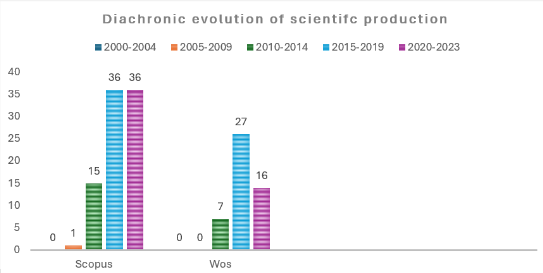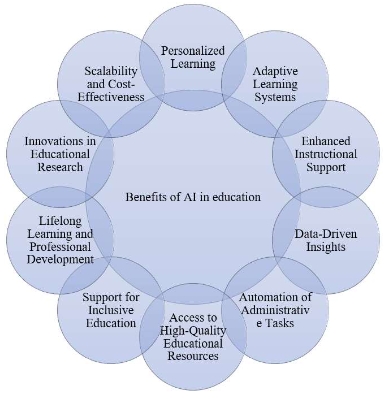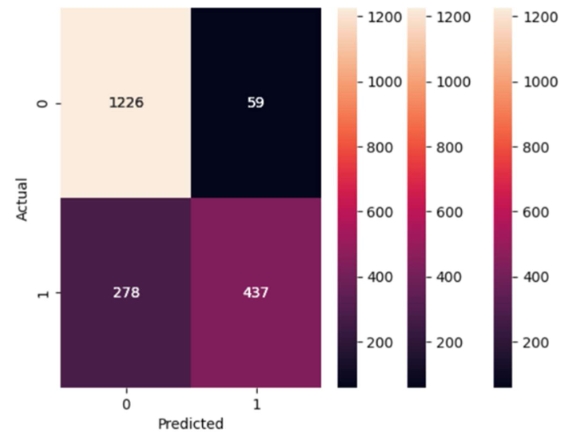A new canvas of learning: Enhancing formal analysis skills in AP art history through AI-generated Islamic art
Abstract
This study explores the use of AI art generators to enhance formal analysis skills in AP Art History students, with a focus on Islamic Art and Architecture. Students, often entering the course with high academic achievements, find the unique challenge of articulating detailed visual descriptions of artwork. The study’s approach involves using AI image-generation websites, like wepik.com, where students create AI images resembling Islamic artworks studied in class. This method aims to refine their descriptive skills, focusing on visual evidence rather than relying on identifying details. The choice of Islamic art, markedly different from other historical periods covered in the curriculum, is intended to boost retention and learning engagement. The results show that students were more successful in describing architectural artworks compared to two-dimensional narrative pieces, with limited site access and the need for iterative description refinement being key challenges. Successful attempts were marked by precise vocabulary usage and detailed descriptions, resulting in AI images closely matching the original artworks. In contrast, less successful attempts revealed deficiencies in comprehensive and detailed descriptions, particularly in narrative artworks. These outcomes highlight the potential and limitations of AI tools in art history education, suggesting that their effectiveness depends largely on the depth and precision of student inputs. The study not only demonstrates the innovative application of AI in education but also underscores the importance of detailed visual analysis, pointing towards future enhancements in AI-assisted educational methodologies.
References
[1]Donahue-Wallace K, La Follette L, Pappas A. Teaching Art History with New Technologies: Reflections and Case Studies. Cambridge Scholars Publishing; 2009.
[2]Kutis B. Scaffolding the Formal Analysis Assignment in Art History Courses to Promote Learning. Journal of Teaching and Learning with Technology. 2020; 9(1). doi: 10.14434/jotlt.v9i1.29162
[3]DOW AW. Composition. University of California Press; 2023. doi: 10.2307/jj.8441755
[4]Black CV, Barringer T. Decolonizing Art and Empire. The Art Bulletin. 2022; 104(1): 6-20. doi: 10.1080/00043079.2021.1970479
[5]Graham ME, Bailey C. Digital images and art historians – Compare and contrast revisited. Art Libraries Journal. 2006; 31(3): 21-24. doi: 10.1017/s0307472200014565
[6]Alpers S. Ut Pictura Noesis? Criticism in Literary Studies and Art History. In: Cohen R (editor). New Directions in Literary History. Routledge; 2022. pp. 199-220. doi: 10.4324/9781003247937-12
[7]Hutson J, Olsen T. Digital Humanities and Virtual Reality: A Review of Theories and Best Practices for Art History. International Journal of Technology in Education. 2021; 4(3): 491-500. doi: 10.46328/ijte.150
[8]Hutson J, Olsen T. Virtual Reality and Art History: A Case Study of Digital Humanities and Immersive Learning Environments. Journal of Higher Education Theory and Practice. 2022; 22(2). doi: 10.33423/jhetp.v22i2.5036
[9]Zullich M, Macovaz V, Pinna G, et al. An Artificial Intelligence System for Automatic Recognition of Punches in Fourteenth-Century Panel Painting. IEEE Access. 2023; 11: 5864-5883. doi: 10.1109/access.2023.3236502
[10]Hutson J, Robertson B. Exploring the Educational Potential of AI Generative Art in 3D Design Fundamentals: A Case Study on Prompt Engineering and Creative Workflows. Global Journal of Human-Social Science: A Arts & Humanities-Psychology. 2023; 23(2).
[11]Gu J, Han Z, Chen S, et al. A systematic survey of prompt engineering on vision-language foundation models. arXiv. 2023; arXiv:2307.12980. doi: 10.48550/arXiv.2307.12980
[12]Walton N. There are no formal elements. In: Addison N, Burgess L (editors). Debates in Art and Design Education, 2nd ed. Routledge; 2020. pp. 72-81. doi: 10.4324/9780429201714-5
[13]Gasper-Hulvat M. Active learning in art history: A review of formal literature. Art History Pedagogy & Practice. 2017; 2(1): 2.
[14]Avci H, Pedersen S, Thomas A. Writing a Formal Analysis of Art in a Game-Based Learning Environment. In: EdMedia and Innovate Learning. Association for the Advancement of Computing in Education (AACE); 2020. pp. 669-671
[15]Elgammal A, Liu B, Kim D, et al. The Shape of Art History in the Eyes of the Machine. Proceedings of the AAAI Conference on Artificial Intelligence. 2018; 32(1). doi: 10.1609/aaai.v32i1.11894
[16]Freedman K. Teaching Visual Culture: Curriculum, Aesthetics, and the Social Life of Art. Teachers College Press; 2003.
[17]Olin M. Formal Analysis: Art and Anthropology. In: Morris-Reich A, Rupnow D (editors). Ideas of ‘Race’ in the History of the Humanities. Palgrave Macmillan; 2017. pp. 89-111. doi: 10.1007/978-3-319-49953-6_3
[18]Prown JD. Style as Evidence. Winterthur Portfolio. 1980; 15(3): 197-210. doi: 10.1086/495962
[19]Locher P, Krupinski E, Schaefer A. Art and authenticity: Behavioral and eye-movement analyses. Psychology of Aesthetics, Creativity, and the Arts. 2015; 9(4): 356-367. doi: 10.1037/aca0000026
[20]Nelson A. Visual Thinking Strategies from the Museum to the Library: Using VTS and Art in Information Literacy Instruction. Art Documentation: Journal of the Art Libraries Society of North America. 2017; 36(2): 281-292. doi: 10.1086/694244
[21]Dolšina M. Educational role of art history as a school subject area in programmes of formal education in Slovenia: the aspect of vzgoja, according to general European guidelines. Journal of Education Culture and Society. 2020; 6(1): 227-241. doi: 10.15503/jecs20151.227.241
[22]Mazzone M, Elgammal A. Art, Creativity, and the Potential of Artificial Intelligence. Arts. 2019; 8(1): 26. doi: 10.3390/arts8010026
[23]Dehouche N, Dehouche K. What’s in a text-to-image prompt? The potential of stable diffusion in visual arts education. Heliyon. 2023; 9(6): e16757. doi: 10.1016/j.heliyon.2023.e16757
[24]Jiang HH, Brown L, Cheng J, et al. AI Art and its Impact on Artists. In: Proceedings of the 2023 AAAI/ACM Conference on AI, Ethics, and Society; 8-10 August 2023; Montreal, QC, Canada. pp. 363-374. doi: 10.1145/3600211.3604681
Copyright (c) 2024 Krista Carpino, James Hutson

This work is licensed under a Creative Commons Attribution 4.0 International License.









